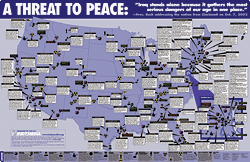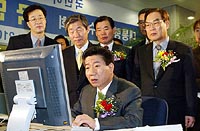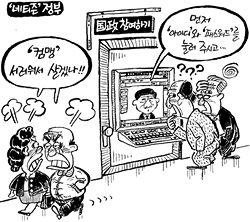war
Psyops Comics IV: Viet Nam

“Honey, what do they say in those leaflets?”
“They are the same as those wall posters, as well as the announcements on the radio yesterday. The two Communists Ba Luong and Hai Gon are presently hiding our village in order to collect taxes. I am determined to report to the Phoenix Operation Committee because I know their hiding place.”
We’ve seen the CIA use comics to fight the Sandinistas; the FBI to fight the Black Panther Party; and with the Comics Code Authority to portray the CIA, ethnic advancement agencies, and the economically privileged in a positive light for U.S. comics readers. The CIA also used comics during the Vietnam War as part of its psychological operations and counterinsurgency campaign.
The comic book, “Mr. Ba’s Family and the Phoenix Operation,” was prepared and disseminated by U.S. forces in South Viet Nam under Operation Phoenix. Operation Phoenix was designed to assassinate or imprison members and collaborators of the National Liberation Front, the united front that brought together Communists and non-Communists to liberate Viet Nam from foreign control.
“Phoenix offices were set up from Saigon down to the district level. Their functions were to: (1) collate intelligence about the ‘Vietcong Infrastructure’; (2) interrogate civilians picked up at random by military units carrying out sweeps through villages; (3) ‘neutralize’ targeted members of the NLF. This third task was often carried out by CIA-led Vietnamese organized into Provincial Reconnaissance Units.”
The comic the fictional story of “Mr. Ba,” who is conviced and eventually rewarded for informing the U.S. military about where the Viet Cong are hiding in his village.
Read more about the comic or See pages from the comic and an English translation. Note, the page and images load slowly.)
On July 19, 1971, William Colby, the CIA officer in charge of Operation Phoenix, testified before a Subcommittee of the House Committee on Government Operations, that between 1968 and May 1971, 20,587 alleged Vietcong sympathizers were executed as a result of the Phoenix Program. The government of South Vietnam credited Phoenix with 40,994 deaths. Vietnamese who were taken into custody were often tortured before being executed. U.S. military-intelligence officer, K. Barton Osborn testified that none of those ever held for questioning lived through the process. (New York Times, August 3, 1971, p. 10.)
The Memory Hole has posted a collection of CIA documents from the Phoenix Program online.
The Committee to Help Unsell the War
In 1969, Arkansas Senator J. William Fulbright, announced the results of his investigation into the Defense Department’s lavish spending on propaganda and self-promotion during the Vietnam War.
Mitchell Hall writes in Unsell the War: Vietnam and Antiwar Advertising, (Historian, Autumn 1995):
“From 1959 to 1969, the Pentagon’s public relations expenditures increased 1,000 percent to an acknowledged $27.9 million, a figure Fulbright called ‘conservative.’ With this financing and a full-time public information force of 2,800 people, the military enjoyed overwhelming access to the public. In 1968 the navy and marines sent over 2.8 million news releases to 12,000 print and broadcast media outlets, in 1969 armed forces performances ranging from musical groups to aerial demonstrations played to audiences estimated at 20 million, and over 360 commercial and educational television stations used the U.S. Army-produced TV show ‘Big Picture.’ The potential influence on public opinion and foreign policy was enormous.
U.S. presidents from Harry Truman to Richard Nixon had also tried to persuade the public that events in Indochina demanded a U.S. military presence. Their efforts initially succeeded, but by the late 1960s millions of Americans had publicly demonstrated their rejection of a policy that had brought increasing sacrifice, destruction, and stalemate. Nixon’s Vietnamization policy, which gradually removed U.S. ground troops but escalated the bombing, partially defused antiwar activity by early 1971. Decreasing U.S. casualties convinced many people that the war was winding down. Although massive public demonstrations occurred less frequently than before, citizens in the early 1970s continued to work to end the war in numerous and creative ways.
On February 23, 1971, CBS broadcast the documentary “The Selling of the Pentagon.”
“Reiterating many of the points addressed in Fulbright’s report, this hour-long program examined the Defense Department’s public relations efforts that, in addition to recruiting volunteers and providing information, marketed a specific interpretation of the Vietnam War and the cold war to the U.S. public....
The military establishment annually arranged hundreds of public contacts that included shopping mall exhibits, Green Beret hand-to-hand combat demonstrations, and tours by flight teams such as the Thunderbirds. In clear violation of regulations, a select group of colonels avidly promoted the U.S. presence in Vietnam in speeches they gave around the country. The Defense Department also provided weekend guided tours of military installations to VIPs, who could observe war games from a grandstand and personally fire tank guns and artillery.
Films also propagated the military’s ideology. The Pentagon cooperated with Hollywood producers who portrayed the military favorably and had celebrities and journalists narrate some of its own movies....
The Defense Department achieved its widest exposure through the news media. Daily briefings to the national press yielded only carefully selected information from the Pentagon’s public relations division. The armed forces also maintained their own media arm, producing over two million press releases each year. Local newspapers generally snapped up uncritically this flood of news about the awarding of medals and promotions. Military television crews provided combat footage to supplement network coverage but often staged the action. Similarly military officials frequently held pre-interview briefings with soldiers in the field to ensure a standard acceptable story before allowing network TV reporters access to them. CBS questioned the impact on a democratic society and free press of a vast military information system that portrayed violence as glamorous, advertised expensive weapons like cars, and presented biased opinion as fact.”
Ira Nerken, a junior at Yale University studying political science, missed the initial broadcast of ”The Selling of the Pentagon” but read about the controversy it provoked. He decided that the war could be ‘unsold’ to the American public. Print ads had occasionally appeared in leading newspapers, and ad hoc groups produced some radio and television spots, but the advertising world had never been tapped on a large scale.
After discussing his ideas with an instructor at Yale, the instructor introduced him to David McCall, president of LaRoche, McCaffrey & McCall, an ad agency in New York. McCall and James McCaffrey, the agency’s chair, quickly organized a team that produced a poster and letter of explanation seeking support for a campaign to unsell the war. These were sent to 80 executives in 60 agencies.
The initial poster featured a drawing of the Pentagon and the headline, “Help unsell the war.” It read:
“C.B.S. recently devoted an hour to documenting the enormous advertising and public-relations job the Pentagon has done to sell the American public its version of the war. A group of students and faculty at Yale University are asking the men and women of the advertising agency business who disagree with the Pentagon’s version of the war to create advertising in all forms that will help unsell the war.”
The letter closed:
“Needless to say, we are not interested in cheap, superficial, anti-American work, we are interested in thoughtful and honest advertising, created by people who love their country.
I hope you will agree with me that this is a vital contribution which our business can make. If you do not agree, I can understand that, too. But the Pentagon’s side of the story has been ably and massively told. Ours has not.”
 Interested ad executives were invited to briefing at Yale University on April 3, 1971.
Interested ad executives were invited to briefing at Yale University on April 3, 1971.
“Over two hundred New York advertising people attended the early April briefing at Yale’s law school auditorium. Paul Warnke, former assistant secretary of defense, and Morton Halperin, former deputy assistant secretary of defense, explained Nixon’s Vietnam policies, and both urged setting a deadline for total withdrawal of U.S. troops. A representative of Vietnam Veterans Against the War discussed war crimes and problems veterans faced. A member of Concerned Asian Scholars described corruption within the Saigon government and the spreading antiwar feeling in South Vietnam. A person from the Herbicide Assessment Commission to South Vietnam showed slides of defoliation and crop destruction, and a former ABC correspondent in Vietnam detailed the strained relationship between the press and the military. Perhaps the most influential speaker was Milton Rosenberg, professor of social psychology from the University of Chicago. He identified the constituencies most ambivalent about the war and the arguments most likely to turn them against it: the deaths of U.S. troops, the economic consequences for the United States, and the creation of national discord.”
After the briefing, the attendees were asked to produce ads to be reviewed on May 1 by a panel that included Kingman Erewster, president of Yale; Mort Halpern, former Deputy Assistant Secretary of Defense; Dr. Edwin Reischauer, former Ambassador to Japan, and Gen. David M. Shoup of the United States Marine Corps (retired.) The panel would evaluate the ads and eliminate those that were inaccurate, unfair, or inferior.
On Memorial Day, May 31, the ads and commercials were to be displayed and distributed to the media to run as a public service.
Over 300 writers, artists, directors, and producers from nearly 50 ad agencies contributed an estimated $1 million of time and expenses. As of June 8, 1971, 125 print ads, 33 TV commercials and 31 radio spots had been produced. Given the expense of reproducing the ads, only a handful were sent to media outlets.
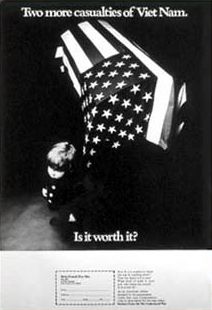 Though the Committee never did convince the major broadcast networks to air the ads, over 100 TV stations and 350 locally owned radio stations around the U.S. did run the spots. During the summer of 71, Nerken was able to arrange free time on 285 billboards around the country. Many of the ads urged people to elect representatives who would vote to end the war by the end of the year.
Though the Committee never did convince the major broadcast networks to air the ads, over 100 TV stations and 350 locally owned radio stations around the U.S. did run the spots. During the summer of 71, Nerken was able to arrange free time on 285 billboards around the country. Many of the ads urged people to elect representatives who would vote to end the war by the end of the year.
“With its attention focused on production rather than marketing, Unsell encountered additional problems inherent in the campaign. It lacked a built-in constituency or the organizational resources to conduct a national distribution effort. Local media felt little pressure to run ads offered by mail from New York. The result was a relative lack of success in getting messages on the air and in print. Because many ads focused on U.S. casualties, the sell became harder as Vietnamization brought more U.S. troops home in favor of an escalated air war, diluting one of the Unsell campaign’s central themes.”
In 1972, the expense and demands of the campaign ultimately led to its transfer to Clergy and Laymen Concerned, the nation’s largest religiously oriented antiwar organization. The focus of ad production also shifted from New York City to Hollywood. The CALC’s network of local chapters were also able to decentralize the task of contacting local media for free time and space. National organizations such as the American Friends Service Committee, Another Mother For Peace, and the Fellowship of Reconciliation also urged their members to get involved in the campaign.
In addition to the decline in U.S. casualties, the ongoing financial burden of the campaign and the 1972 presidential election slowed the momentum of the project which ultimately ended after the reelection of President Nixon and his announcement in January 1973 of an accord with North Viet Nam to end American involvement in Indochina.
The Library of Congress has several thumbnail images of posters produced by the Committee. Click on ‘Preview Images.’
A Threat to Peace, U.S.A.
“The Indypendent - the monthly newspaper of the NYC-Indymedia Center proudly presents ... A Threat to Peace - a handy poster-sized color map of U.S. terrorist infrastructure.
Whether you’re a budding weapons inspector or just a trivia buff, A Threat to Peace can give you the scoop on nuclear manufacturing facilities, chemical and biochemical weapons facilities, weapons manufacturers, nuclear testing and launch sites, and much, much more.”
Download the poster or order one.
Points of interest include:
- Chemical Weapons
- Domestic War Criminals
- Imported War Criminals
- Private Mercenary Companies
- Military Sites
- Biological Weapons
- Nuclear Weapons
- Terrorist Training Camps
- Rest & Recreation
- Militarization of Space
- Major Weapons Makers
- Universities, Policy Institutes & Think Tanks
- Nuclear Facilities
- Ballistic Missile Defense
Graphic Designers Against the War in Iraq

“ANTI-WAR.US is dedicated to the free distribution of anti-war graphic material.
As creative individuals trained in methods of mass-communication, we can make a real difference by providing clear anti-war messages.
All materials on this site are created voluntarily and distributed free to activists around the world.”
A nice idea. I’m kicking myself for not thinking of it. Will send one of my own poster ideas shortly.
I do hope they will excercise some curatorial judgement, though. I’m a long-time admirer of Charles Wilkin’s design work. I’ve even used one of his fonts, but painting President Bush in the same league as Stalin and Hitler does not help the credibility of your cause.
via American Samizdat. Image above by M. Musri, Fabrica.
Anti-War TV
Anti-War Group Revives “Daisy” Ad Campaign, January 15, 2003
From AP:
“Revisiting one of the most effective television commercials in the annals of U.S. politics, a grassroots anti-war group has produced a remake of the ‘Daisy’ ad, warning that a war against Iraq could spark nuclear Armageddon.
The provocative 30-second commercial - released to the media Wednesday and appearing in 12 major U.S. cities on Thursday at a cost of $400,000, was prepared with the help of thousands of donations to the Internet-based group MoveOn.org.
 The original Daisy ad aired only once, during the 1964 presidential race. Produced by the campaign of incumbent Lyndon B. Johnson, it depicted a 6-year-old girl plucking petals from a daisy - along with a missile launch countdown and then a nuclear mushroom cloud. The suggestion was that if elected president, Republican Barry Goldwater might lead the United States to a nuclear war with the Soviet Union. Goldwater lost by a wide margin.
The original Daisy ad aired only once, during the 1964 presidential race. Produced by the campaign of incumbent Lyndon B. Johnson, it depicted a 6-year-old girl plucking petals from a daisy - along with a missile launch countdown and then a nuclear mushroom cloud. The suggestion was that if elected president, Republican Barry Goldwater might lead the United States to a nuclear war with the Soviet Union. Goldwater lost by a wide margin.
The 2003 version follows the same format, with an added montage of scenes of military escalation: burning oil wells, tanks in the battlefield, wounded soldiers, chaotic protests in a foreign city and an ambulance racing through U.S. streets. Then, a similar mushroom cloud, and the screen goes to black, with a dire warning: ‘War with Iraq. Maybe it will end quickly. Maybe not. Maybe it will spread. Maybe extremists will take over countries with nuclear weapons. Maybe the unthinkable.’
Then, another ‘10... 9... 8...,’ countdown, and a final message: ‘Maybe that’s why the overwhelming majority of Americans say to President Bush: let the inspections work.’
MoveOn.org’s leaders hope the ad will enliven the debate on the specter of war - and persuade Americans to oppose a military solution in Iraq.
‘We’re playing with matches in a tinderbox,’ Eli Pariser, MoveOn.org’s international campaign director said. ‘We wanted to run an ad that would highlight that very real possibility and help encourage a national discussion about the consequences of war.’”
MoveOn was started in 1998 by a couple of guys in Silicon Valley as an online petition encouraging Congress to resolve the long running investigation and impeachement proceedings of President Clinton. Their email list has since grown to 600,000 users, and the org now solicits contributions for its Political Action Committee, MoveOnPAC, whose campaign contributions “provide financial support to congressional candidates who embrace moderate to progressive principles of national government. Our intention is to encourage and facilitate smaller donations to offset the influence of wealthy and corporate donors.”
On the ad:
“In December, we asked members to contribute $27,000 for a print ad in the New York Times. Within days, we had more than $400,000 committed to our ad campaign. This allowed us to do several print ads, including an ad in USA Today. To follow up, we ran a radio ad created by Betsey Binet, one of our members. But once we saw the avalanche of support, we knew it was time to go to TV. Over the holidays, we worked on the spot you’ll see today. Our goal is to underline the risk of war and we’ve created a piece intended to provoke discussion and controversy....
The ad is airing on TV stations in Washington, DC, Los Angeles, San Francisco, Philadelphia, Chicago, Dallas, Miami, Boston, Minneapolis, Phoenix, Cleveland, Portland and Seattle. The ad buy is largely on cable networks, and will show heavily on public interest shows on channels such as CNN and MSNBC for the next week. At 10am today in each of these media markets, MoveOn volunteers will be running press conferences for the local media.”
A RealVideo version of the ad is up on their Web site.
It’s great to see the anti-war message breaking through the virtual ban on dissent in the mainstream media. I hope this will help create a space for the media to cover this weekend’s protests in D.C. and around the world.
The ad is also a good effort to try to show some of the consequences of the war on TV, but images of mushroom clouds don’t quite evoke the human cost for me. Cinematic explosions are pretty cheap these days. I suppose the zoom on the little white girl tries to do this by implication.
The message of the ad also seems a bit muddled. The ad urges Bush to “let the inspections work.” But then is it OK to go to war if the inspectons do in fact show Iraq in violation of UN resolutions? Wouldn’t the same costs apply if the U.S. attacked Iraq with the approval of the UN?
Korea’s Internet Election
In South Korea, it’s the mouse that roars
New breed of politician taps the country’s love affair with high tech
“The winning candidate in last week’s South Korean presidential election had little need for mass rallies or traditional campaign tactics.
When Roh Moo-hyun’s organizers wanted supporters to vote on election day, they simply pressed a few computer keys. Text messages flashed to the cellphones of almost 800,000 people, urging them to go to the polls.
During his campaign, millions of voters absorbed Mr. Roh’s message from Internet sites that featured video clips of the candidate and audio broadcasts by disc jockeys and rock stars. Half a million visitors logged on to his main Web site every day to donate money or obtain campaign updates. More than 7,000 voters a day sent him e-mails with policy ideas. Internet chat groups buzzed with debate on the election....
Almost half of South Korean voters are below the age of 40 — a prime demographic for users of the Internet and cellphones. Until this year, many were apathetic politically, put off by the country’s traditional political machinery. But Mr. Roh reached out to voters with one of the world’s most sophisticated Internet campaigns, and the vast majority of the younger population voted for him.
Until a year ago, Mr. Roh was best known for his repeated failures to be elected to parliament. Self-educated, he came from a poor family and had been jailed for helping dissidents fight the military regimes of the past. But young voters admired the lawyer for his integrity and his image as an independent outsider, and they formed an Internet fan club to promote his future.
The Internet allowed Mr. Roh to liberate himself from ‘black money’ — corporate donations that are South Korea’s traditional form of campaign financing. Largely through Internet-based campaign groups, Mr. Roh raised the equivalent of about $1-billion from more than 180,000 individual donors.”
I’m impressed by the apparent influence of the grassroots fan club site. And 7,000 users a day sent the guy policy ideas? It will be interesting to see how President Roh fulfills his promise “to use the Internet to make the government more open and transparent.”
Otherwise, though tech angle is interesting, the article totally takes it out of context. Who else was running? What issues were being discussed? Mr. Roh’s popularity is not just due to his “repeated failures to be elected to parliament” but to the fact that he repeatedly chose to run in districts where he knew he would lose in order to make a statement about the regional election machine. Many Koreans vote for candidates based primarily on what district they are from. Mr. Roh’s campaign runs were a principled stand against this.
Mr. Roh’s popularity is also due to the fact that he was a leader in the pro-democracy movement against the dictatorship of Chun Doo-hwan, was imprisoned for his political activism, and has a solid record as an advocate of human rights. As a lawyer he could have chosen a much more lucrative career instead of defending labor unions, students, and the poor. And, unlike his political rivals, wants to engage more with North Korea. (See the BBC’s profile.)
The real shock of the election is that a liberal candidate was elected after decades of conservative rule. In the past, the three powerful conservative newspapers have pushed hard against liberal candidates, for instance playing up skirmishes in the DMZ around election time to scare voters away from liberal candidates who might not be as tough on the North. In Korea, the “liberal” label has even more sting than in the U.S. Being associated with Communism in the press could end your political career.
But the younger generation does it have the same relationship to the War or the military dictatorship as the older generation. And the under-30 crowd seems to have less aversion to leftist ideas or engagement with the North. The relevance of the Internet is part of the generational and ideological shift of the voting population in Korea.
In addition to a few facts about the Internet in Korea, the Globe article is a lot like typical U.S. election reporting. All tactics, no substance. Who displayed the most charisma? How much did they spend? Who endorsed them? Meanwhile, the chat rooms in Korea are buzzing with debate. I look forward to the day when the decentralized, online discussion is as influential as our mainstream election coverage.
Camp
While browsing the DefenseLINK site looking for some good public domain photos, I found a bunch the Pentagon had recently released of the new U.S. detention center at Guantanamo Bay.
The United States was harshly criticized for the brutal, crude design of Camp X-Ray. Photos were widely circulated of prisoners at squatting in their chain-link cells in the blazing Cuban sun.
Five miles down the road, Camp Delta is now open for business. Photos of a detention block and spotless
cells make it seem like an improvement. (Even the name “Camp Delta” reads like a hokey PR move.) Camp Delta has indoor plumbing, each unit its own flush toilet, metal bed-frame and a sink with running water. None of this was available at Camp X-Ray where buckets and portable toilets were used. No detainees in any of  the new photos, though.
the new photos, though.
The $9.7 million dollar contract for the construction of the camps went to Brown and Root, a subsidiary of Halliburton. The contract could eventually total as much as $300 million if additional options are exercised. Vice President Dick Cheney is the former chief executive officer of Halliburton.
In addition to the new cells, Camp Delta has its own recreation and exercise area, library, outdoor shower, hospital and ward. “Comfort items” distributed to detainees including a prayer mat, cap, flip flops and two-piece suit.
And, dental care is provided at the detainee hospital.
Free dental care? It’s more then most Americans get.
But then another look at that chair and the skin starts to crawl. One suspects the U.S. isn’t terribly concerned with the beautiful smiles of its “enemy combatants.”
Indeed, this morning’s Washington Post describes secret overseas CIA interrogation facilities where detainees are
being tortured. The same torture techniques are of course denounced by the U.S. State Department in its annual survey of human rights violations in other countries. In fact its in some of those very countries where the CIA is setting up shop. Says one U.S. official, “If you don’t violate someone’s human rights some of the time, you probably aren’t doing your job.”
Says Human Rights Watch:
“Direct involvement or complicity in torture, as well as the failure to prevent torture by subordinates, may subject U.S. officials to prosecution under international law. Such acts are ‘grave breaches,’ or war crimes, under the 1949 Geneva Conventions. In addition, the Convention against Torture [which the U.S. has ratified] obligates all countries to prosecute persons within their jurisdiction who are implicated or complicit in acts of torture. Any competent court anywhere in the world is required to prosecute violations of the prohibition against torture.”
According to U.S. officials, nearly 3,000 suspected al Qaeda members and their supporters have been detained worldwide since September 11, 2001.
U.S. Racism in Pictures

“A documentary with 3,000 pictures, music, interviews and narration presented on two screens for audiences of up to 2,000... A lecture on racism, oppression, poverty and social injustice with more than 5,000 presentations in American and European Higher Education.”
...
See also 30 photos from 1937-1943 of signage enforcing racial discrimination. From the Library of Congress:
“Photographers working for the Farm Security Administration Historical Section (later transferred to the Office of War Information) were encouraged to document continuity and change in many aspects of life in America during the years the unit was in operation. They were particularly encouraged to photograph billboards and signs as one indicator of such developments. Although no documentation has been found to indicate that photographers were explicitly encouraged to photograph racial discrimination signs, the collection includes a significant number of this type of image, which is rarely found in other Prints and Photographs Division collections.”
Underexposed
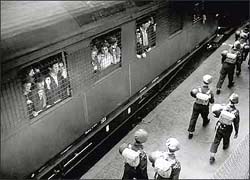 The people in the black and white photo behind the bars of the boxcar in the 1940’s German train station are not Jews off to the camps to be killed. They are indeed German Jews off to a camp, but the photo was taken after the end of war, the soldiers on the platform are British, and the passengers are survivors of Nazi concentration camps, denied entry into Palestine. Here, they are being transported from Hamburg docks to the Poppendorf detention camp.
The people in the black and white photo behind the bars of the boxcar in the 1940’s German train station are not Jews off to the camps to be killed. They are indeed German Jews off to a camp, but the photo was taken after the end of war, the soldiers on the platform are British, and the passengers are survivors of Nazi concentration camps, denied entry into Palestine. Here, they are being transported from Hamburg docks to the Poppendorf detention camp.
The photo and its story are reproduced in Underexposed. From Vision On Publishing:
“Underexposed tells the stories behind the photographs which determine our view of history, providing a reality check on alleged events from the last hundred years and documenting the struggle of the powerful to contend with rival cultural forces of media and information. Reclaimed from the trash cans of the Second World War. From the cruelty of Stalin’s Russia and fundamentalist chaos in Iran to the horrors of the Gulf war and perspectives on September 11th — even Hitler’s preening speech rehearsals come back to argue with his self-made myth. Via disgruntled starlets, ecological destruction and US nuclear tests, Underexposed gathers together some of the most ideologically dangerous photographs ever taken and releases them to haunt the increasingly manipulated, re-touched present.”
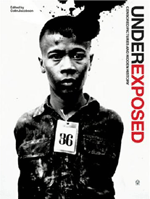 I found the book on the front table at St. Mark’s Books, mixed with the latest compilations on cyber-typography, club flyers, erotica, and graphic novels. The juxtaposition is continued on the publisher’s Web site. Among the publisher’s list of glossy photo books of rock stars, fashion, erotica, and a celebration of the Manchester City Football Club (and its fans), Underexposed seems a bit like war porn. The design of the book is certainly less than sober, full of dramatic, oversized, full-bleed spreads and a hip sans serif typeface. Each photo is provided with some background, but the captions only allow so much space.
I found the book on the front table at St. Mark’s Books, mixed with the latest compilations on cyber-typography, club flyers, erotica, and graphic novels. The juxtaposition is continued on the publisher’s Web site. Among the publisher’s list of glossy photo books of rock stars, fashion, erotica, and a celebration of the Manchester City Football Club (and its fans), Underexposed seems a bit like war porn. The design of the book is certainly less than sober, full of dramatic, oversized, full-bleed spreads and a hip sans serif typeface. Each photo is provided with some background, but the captions only allow so much space.
The bottom line: photographs can lie. Particularly those that purport to be objective. Taken out of context, they are cropped, altered, and framed by the context at hand and by cultural assumptions. And page after page, the flouting of taboo and power starts to flatten out. Like all the speakers in the corner of Hyde Park, all ideologies become equivalent.
That said, the book does rouse a healthy dose of skepticism. It also crosses into the terrain of Barthes’s Mythologies, an examination of connections between language, imagery, ideology, and power and a wandering interrogation of “the obvious.”
From a review in The Guardian:
“In one of the most shocking images, taken from the Sudanese famine of 1984, Wendy Wallace photographed the photographers at work snapping an emaciated child who had been brought out to sit in the dirt precisely for that image.
It is a theme that recurs in Alex Webb’s pictures of the American invasion of Haiti. A line of US troops lies dramatically - heroically - on the Tarmac at Port au Prince airport aiming their weapons at an unseen enemy. Most media organisations showed this image. Webb’s version shows the reality: the only figures are half a dozen and more photographers and cameramen crouched in front of the soldiers, puncturing the dramatic image in a campaign that was to see virtually no opposition to US troops.”
See an excerpt from the forward to the book, some photos from the book, or listen to an audio interview with Colin Jacobson, former photo editor for a number of British news magazines and editor of Underexposed.
...
Also of note, The Commissar Vanishes: The Falsification of Photographs in Stalin’s Russia, an small online exhibit of doctored photos and propaganda posted by the Newseum. Shown here, Stalin with Nikolai Yezhov, commissar of water transport, before and after he was purged.
Make Love, Not War
From The Telegraph, UK:
Arabic love poem puts US Gulf base on red alert
By Jack Fairweather in Kuwait (Filed: 05/12/2002)
US marines in Kuwait were put on full alert yesterday after an unidentified person wrote a love poem in Arabic on a military vehicle.
The marines, unable to translate the simple phrase which begins many Arabic love songs, called the alert when they thought the message contained a terrorist threat. A translator was summoned and confirmed it was merely a poem, the words reading: “I love you forever. Your beauty is incomparable.”
“We’re not used to such things,” said one American soldier serving at Camp Doha, the American military base in Kuwait where troops are preparing for a possible war against Iraq.
It transpired that the message was not meant for the marines but for a lovesick teenager by the name of Fatima.


